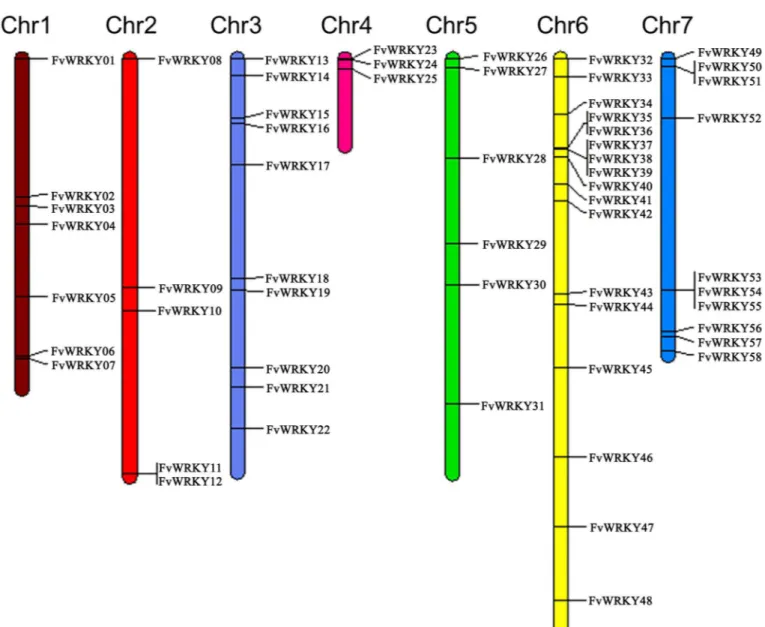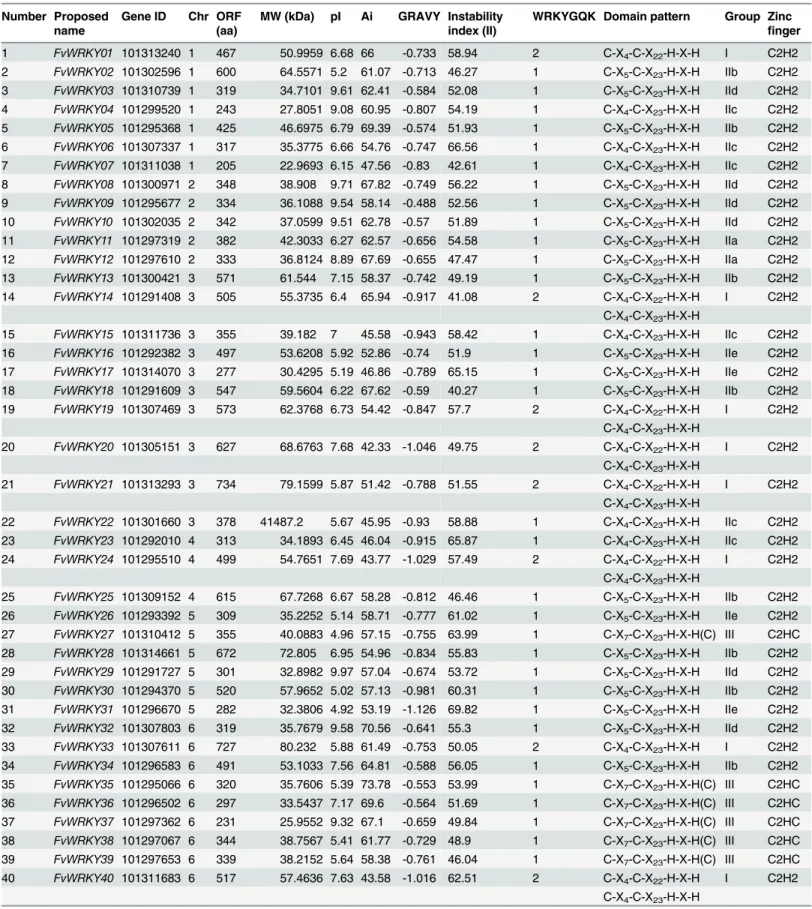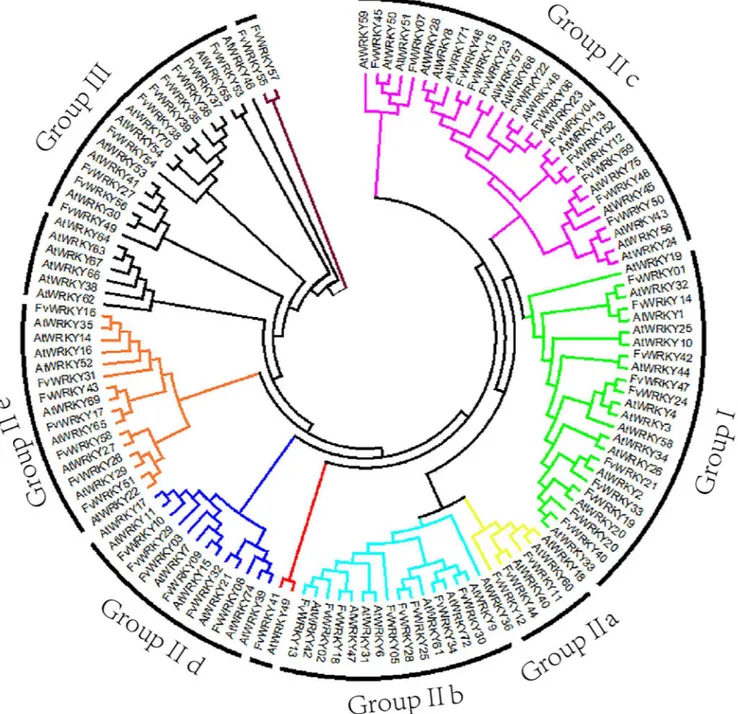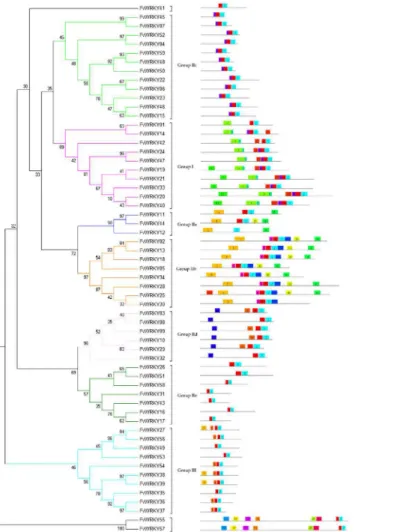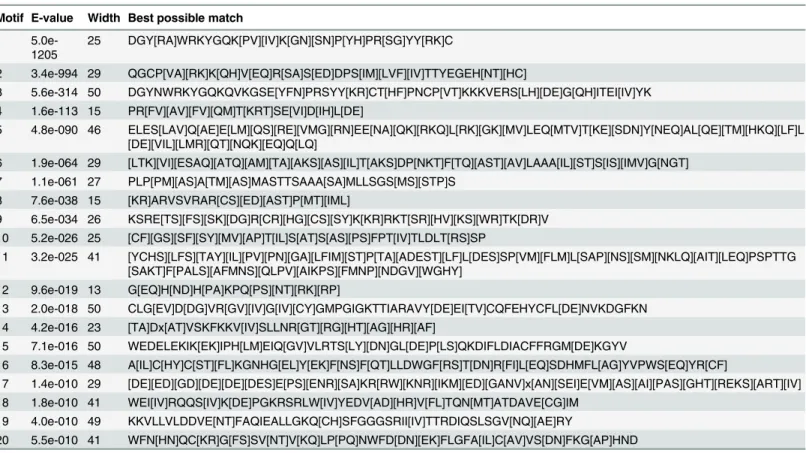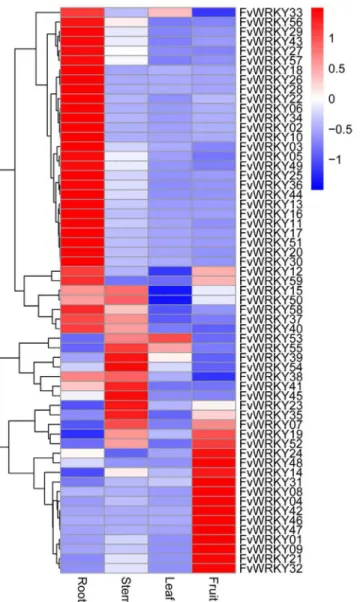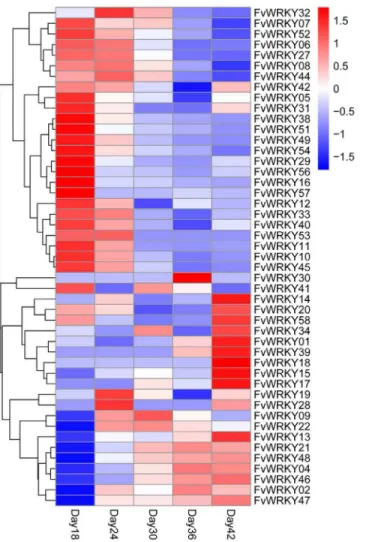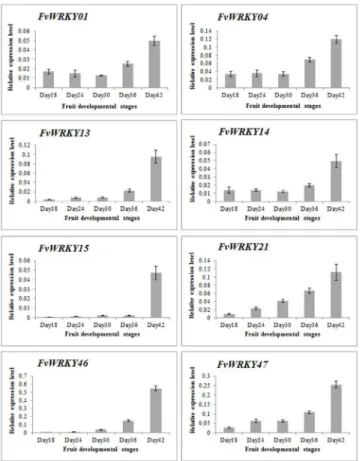Genome-Wide Analysis of the Expression of
WRKY
Family Genes in Different
Developmental Stages of Wild Strawberry
(Fragaria vesca) Fruit
Heying Zhou1,2☯, Yuxuan Li1,2☯, Qing Zhang1,2, Suyue Ren1,2, Yuanyue Shen1,2,
Ling Qin1,2, Yu Xing1,2*
1College of Plant Science and Technology, Beijing University of Agriculture, Beijing, 102206, PR China, 2Beijing Key Laboratory for Agricultural Application and New Technique, Beijing University of Agriculture, Beijing,102206, PR China
☯These authors contributed equally to this work. *xingyu@bua.edu.cn
Abstract
WRKY proteins play important regulatory roles in plant developmental processes such as senescence, trichome initiation and embryo morphogenesis. In strawberry, onlyFaWRKY1
(Fragaria × ananassa) has been characterized, leaving numerous WRKY genes to be identi-fied and their function characterized. The publication of the draft genome sequence of the strawberry genome allowed us to conduct a genome-wide search for WRKY proteins in Fra-garia vesca, and to compare the identified proteins with their homologs in model plants. Fifty-nineFvWRKYgenes were identified and annotated from theF.vescagenome. Detailed analysis, including gene classification, annotation, phylogenetic evaluation, con-served motif determination and expression profiling, based on RNA-seq data, were per-formed on all members of the family. Additionally, the expression patterns of theWRKY
genes in different fruit developmental stages were further investigated using qRT-PCR, to provide a foundation for further comparative genomics and functional studies of this impor-tant class of transcriptional regulators in strawberry.
Introduction
Members of the WRKY class of transcription factors, which are ubiquitous among higher plants, exhibit sequence-specific DNA-binding and are capable of activating or repressing the transcription of downstream target genes [1]. Proteins in this superfamily contain either one or two highly conserved signature domains of approximately 60 amino acid residues, including the conserved WRKYGQK sequence followed by a zinc finger structure in the C-terminal region [2]. Studies have also shown that the conserved WRKY domain can have slightly longer sequences, such as WRKYGKK and WEKYGQK [3], or that it can be replaced by WKKY, WKRY, WSKY, WIKY, WRIC, WRMC, WRRY or WVKY. The conservation of the WRKY
a11111
OPEN ACCESS
Citation:Zhou H, Li Y, Zhang Q, Ren S, Shen Y, Qin L, et al. (2016) Genome-Wide Analysis of the Expression ofWRKYFamily Genes in Different Developmental Stages of Wild Strawberry (Fragaria vesca) Fruit. PLoS ONE 11(5): e0154312. doi:10.1371/journal.pone.0154312
Editor:Ji-Hong Liu, Key Laboratory of Horticultural Plant Biology (MOE), CHINA
Received:January 12, 2016
Accepted:April 12, 2016
Published:May 3, 2016
Copyright:© 2016 Zhou et al. This is an open access article distributed under the terms of the Creative Commons Attribution License, which permits unrestricted use, distribution, and reproduction in any medium, provided the original author and source are credited.
Data Availability Statement:All relevant data are within the paper and its Supporting Information files.
Funding:This work was supported by the National Natural Science Foundation of China (Grant No. 31370323), Beijing Natural Science Foundation and Scientific Research Key Program of Beijing Municipal Commission of Education (Project No.
domain is mirrored by a remarkable conservation of its cognate binding site, the W
box (TTGACC/T) [4–6]. The WRKY domain facilitates binding of the protein to the W box or the SURE (sugar-responsivecis-element) element in the promoter regions of target genes [7, 8]. As described by Eulgem et al. (2000), WRKY proteins can be divided into three major groups based on both the number of WRKY domains and the specific features of their zinc-fin-ger-like motif: WRKY proteins with two WRKY domains containing a C2H2zinc-finger motif
belong to group I, whereas most proteins with one WRKY domain containing a C2H2
zinc-fin-ger motif belong to group II, which can be further divided into five subgroups (IIa, IIb, IIc, IId and IIe). Generally, the same type of finger motif is characteristic for group I and group II members (C-X4-5-C-X22-23-H-X1-H,). Group III consists of a small number of genes
character-ized by a single WRKY domain with a C2HC zinc-finger motif.
Since the first cDNA encoding a WRKY protein,SPF1, was cloned from sweet potato (Ipo-moea batatas) [9], numerous members of the family have been characterized from several plant species, and they have been found to be involved in various physiological processes under normal growth conditions and under various biotic and abiotic stresses [10–20]. There are at least 72 WRKY family members inArabidopsis thalianaand at least 109 in rice (Orza sativa). Furthermore, 55WRKYgenes have been identified in the cucumber (Cucumis sativus) genome and 59 putative grapevine (Vitis vinefera) WRKY transcription factors were also identified fol-lowing a search of various genomic and proteomic grapevine databases [21,22]. Many of theA. thalianaWRKY proteins appear to be involved in regulating the balance between salicylic acid (SA)- and jasmonic acid (JA)-dependent defense pathways. One example is AtWRKY70, a common regulatory component of SA- and JA-dependent defense signaling, which mediates the cross-talk between these antagonistic pathways and is a positive regulator of R-gene medi-ated resistance and systemic defense responses [23,24]. Microarray analyses have revealed that expression of some of theA.thalianaWRKY transcripts is strongly regulated by various abiotic stresses, such as salinity, drought and cold [25,26]. Moreover, abiotic stresses (salinity, drought and cold) and phytohormone treatments were reported to result in changes in the transcript levels of 54 riceWRKYgenes [20]. Finally, WRKY proteins are also known to play important regulatory roles in developmental processes such as senescence, trichome initiation and embryo morphogenesis [27–30].
While the WRKY family has been well studied in model experimental plants, such asA. thalianaand rice, less is known about their function and regulation in other species, including those of agronomic or horticultural value. In this study we used as our experimental systemF. vesca, the wild strawberry, which is diploid, unlike cultivated strawberry (Fragaria × ananassa) is octoploid.F.vescatherefore has a relatively small (~240 Mb) genome, which has been sequenced, as well as a short life cycle (3.5 to 4 months) and a facile transformation system. These characteristics have resulted in a substantial increase in the number of physiological and molecular studies of this species. In cultivated strawberry, onlyFaWRKY1has been character-ized to date and it has been shown to be involved in mediating defense responses to the fungus Colletotrichum acutatum. Specifically, the expression ofFaWRKY1is up-regulated in straw-berry followingC.acutatuminfection, treatments with elicitors, and wounding [31]. However, to our knowledge, there are no reported studies ofWRKYgenes fromF.vescaand nothing is known of their potential association with fruit development and ripening. This is of particular interest given that strawberry is not only an economically important cultivated fruit crop, but also a model system for studies of these processes.
In this current study we identified a total of 59FvWRKYgenes from the recently reportedF. vesca‘Hawaii 4’genome sequence [32]. We report here the classification, annotation and phy-logenetic evaluation of these genes, together with an assessment of conserved motifs and the results of expression profiling of members of theWRKYgene family, based on RNA-seq data. Competing Interests:The authors have declared
The expression patterns ofWRKYgenes in different fruit developmental stages were further investigated using quantitative real-time reverse transcription PCR (qRT-PCR). Our results provide a foundation for further comparative genomics and functional studies of this class of transcriptional regulators in strawberry.
Materials and Methods
Identification of Putative
F
.
vesca WRKY
Genes
To generate a comprehensive list ofF.vesca WRKYgenes, annotated strawberry protein sequences were downloaded from the public databases,F.vescaBioView Gene Model Database (https://strawberry.plantandfood.co.nz/) and Genome Database for Rosaceae (http://www. rosaceae.org/species/fragaria/fragaria_vesca/genome_v2.0.a1). TheArabidopsis WRKYgene family database was obtained from TAIR (TheArabidopsisInformation Resource,http://www. arabidopsis.org) and used for comparative analysis.
Gene Structure Construction, Phylogenetic Analysis and Classification
of the
F
.
vesca
WRKY Family
All identifiedF.vesca WRKY(FvWRKY) genes were classified into different groups based on theAtWRKYclassification scheme, and the alignment ofFvWRKYandAtWRKY DNA-bind-ing domains was performed usDNA-bind-ing Clustal X 2.147 [33] with default settings. The phylogenetic trees were created using MEGA 5.0 [34] and the neighbor-joining method. Bootstrap values were calculated for 1,000 iterations.
Analysis of the
FvWRKY
Exon-Intron Structures and Chromosomal
Location
The exon-intron organization of theFvWRKYgenes and their location on strawberry chromo-somes were determined based on information available at the National Centre for Biotechnol-ogy Information (NCBI;http://www.ncbi.nlm.nih.gov).
Plant Material and Fruit Pre-Treatments
F.Vesca(‘Hawaii 4’) were cultivated in growth chamber at 22±1°C in a 13/11 h dark/light pho-toperiod. Fruit samples were harvested at 18, 24, 30, 36 and 42 DAF (days after flowering). At each developmental stage, ten representative fruits were sampled, snap-frozen in liquid nitro-gen and kept at -80°C until further use. For different pre-treatment experiments, two stages (18 and 36 DAF) were selected for sucrose and hormone treatments. The fruits were cut in half longitudinally, and half was used for processing while the other half was used as a control. The hormones used for treatments were indole-3-acetic acid (IAA) and abscisic acid (ABA), each at a concentration of 100μM and the sucrose concentration used was 50μM. All experiments
were performed at 25°C.
RNA Extraction, RNA-Seq Based Expression Analysis and Real-Time
PCR Analysis
Light Cycler1
96 SW1.1 Real Time PCR System (Roche), with SYBR-Green (Takara, Dalian, China). The primer sequences used (S1 Table) were designed based onWRKYgene sequences using the Beacon designer software. These sequences were subsequently verified using the BLAST tool at NCBI and a dissociation curve was also analyzed after the PCR reaction to con-firm their specificity. Each reaction was carried out in a 10μL volume, consisting of 5μL SYBR,
3.5μL ddH2O, 1μL diluted template (1μL of the generated first-strand cDNA diluted by 9μL
ddH2O) and 0.25μL of each of two gene specific primers. The following program was used for
RT-PCR: 95°C for 10 min followed by 40 cycles at 95°C for 20 s, 54°C for 20 s, 72°C for 20 s.
Results
Identification and Annotation of the Strawberry WRKY Family and Its
Chromosomal Distribution
A total of 59 full length gene sequences were identified in the strawberry genome as putative members of theWRKYsuperfamily All the 59 gene sequences were obtained from theF.vesca Whole Genome v2.0.a1 Assembly & Annotation (https://www.rosaceae.org/species/fragaria_ vesca/genome_v2.0.a1). All 58 identifiedWRKYgenes were mapped to the respective chromo-somes and were renamed fromFvWRKY1toFvWRKY58, based on their order on the chromo-somes, from chromosomes 1 to 7 (Fig 1) [35]. The parameters used to characterize each of the predicted FvWRKY proteins are listed inTable 1, and included the deduced protein length, molecular weight, isoelectric point, aliphatic index and grand average of hydropathicity. The deduced length of the FvWRKY proteins ranged from 155 (FvWRKY45) to 1,348 amino acids (FvWRKY55), while the pI values ranged from 4.92 (FvWRKY31) to 9.97 (FvWRKY29), which suggests that different FvWRKY proteins might operate in different microenvironments.
Using TblastN, 58 out of the 59FvWRKYgenes could be mapped toF.vescachromosomes, indicating an unevenly comprehensive distribution ofFvWRKYswithin strawberry genome (Fig 1). OneWRKYgene (101290922) could not be conclusively mapped to any chromosome and was renamedFvWRKY59. Chromosome 6, contained the largest number (17) ofFvWRKY genes, followed by chromosome 3 and 7, each of which had tenFvWRKYgenes. Seven were mapped to chromosome 1 and three to chromosome 4. Chromosomes 2 and 5 had five and six FvWRKYgenes, respectively. According to the definition of a gene cluster provided by Holub [36], twelveFvWRKYgenes were present in five clusters, of which two were on each of chro-mosomes 6 and 7, and one cluster was on chromosome 2 (Fig 1).
FvWRKY
Exon and Intron Organization
To investigate the structural evolution of theF.vescaWRKY family, the exon-intron patterns were analyzed. The number of introns ranged from one to twenty (Fig 2), and a large number of genes contained two introns, while eight genes contained three introns and nine contained four introns. TheFvWRKY44andFvWRKY57genes contained seven introns,FvWRKY2and FvWRKY13contained eight introns andFvWRKY26andFvWRKY35contained nine introns. FvWRKY43andFvWRKY55contained ten and twenty introns, respectively. Two genes con-tained only one intron andFvWRKY50had no introns.
belonging to groups IIa and IIb, whereas the R-type intron was widely distributed amongst all other FvWRKY groups (S1 Fig).
Phylogenetic Analysis, Classification and Motif Analysis of the
F
.
vesca
WRKY
Gene Family
The distribution of structural domains can provide important insights into the evolution and relationship between highly divergent sequences [36]. Sequence comparisons, as well as phylo-genetic and structural analyses showed that theA.thalianaWRKY domains could be classified into four large groups, termed groups I, II, III and IV [2]. Ten of the FvWRKY proteins belong to Group I, members of which contain two complete WRKY domains and a C2H2-type zinc
fin-ger motif (C-X4-C-X22-23-H-X1-H). Ten FvWRKY proteins, each with a single WRKY domain, Fig 1. Chromosomal distribution of theFragaria vescaL.WRKYgene family.Chromosome size is indicated by relative length. The putative
WRKYgenes fromFvWKRY1toFvWRKY58were renamed based on their placement on the chromosomes. Only one gene,FvWRKY59, was not assigned to any chromosome.
Table 1. WRKYgenes identified inFragaria vesca.
Number Proposed Gene ID Chr ORF (aa)
MW (kDa) pI Ai GRAVY Instability index (II)
WRKYGQK Domain pattern Group Zinc
finger name
1 FvWRKY01 101313240 1 467 50.9959 6.68 66 -0.733 58.94 2 C-X4-C-X22-H-X-H I C2H2
2 FvWRKY02 101302596 1 600 64.5571 5.2 61.07 -0.713 46.27 1 C-X5-C-X23-H-X-H IIb C2H2
3 FvWRKY03 101310739 1 319 34.7101 9.61 62.41 -0.584 52.08 1 C-X5-C-X23-H-X-H IId C2H2
4 FvWRKY04 101299520 1 243 27.8051 9.08 60.95 -0.807 54.19 1 C-X4-C-X23-H-X-H IIc C2H2
5 FvWRKY05 101295368 1 425 46.6975 6.79 69.39 -0.574 51.93 1 C-X5-C-X23-H-X-H IIb C2H2
6 FvWRKY06 101307337 1 317 35.3775 6.66 54.76 -0.747 66.56 1 C-X4-C-X23-H-X-H IIc C2H2
7 FvWRKY07 101311038 1 205 22.9693 6.15 47.56 -0.83 42.61 1 C-X4-C-X23-H-X-H IIc C2H2
8 FvWRKY08 101300971 2 348 38.908 9.71 67.82 -0.749 56.22 1 C-X5-C-X23-H-X-H IId C2H2
9 FvWRKY09 101295677 2 334 36.1088 9.54 58.14 -0.488 52.56 1 C-X5-C-X23-H-X-H IId C2H2
10 FvWRKY10 101302035 2 342 37.0599 9.51 62.78 -0.57 51.89 1 C-X5-C-X23-H-X-H IId C2H2
11 FvWRKY11 101297319 2 382 42.3033 6.27 62.57 -0.656 54.58 1 C-X5-C-X23-H-X-H IIa C2H2
12 FvWRKY12 101297610 2 333 36.8124 8.89 67.69 -0.655 47.47 1 C-X5-C-X23-H-X-H IIa C2H2
13 FvWRKY13 101300421 3 571 61.544 7.15 58.37 -0.742 49.19 1 C-X5-C-X23-H-X-H IIb C2H2
14 FvWRKY14 101291408 3 505 55.3735 6.4 65.94 -0.917 41.08 2 C-X4-C-X22-H-X-H I C2H2
C-X4-C-X23-H-X-H
15 FvWRKY15 101311736 3 355 39.182 7 45.58 -0.943 58.42 1 C-X4-C-X23-H-X-H IIc C2H2
16 FvWRKY16 101292382 3 497 53.6208 5.92 52.86 -0.74 51.9 1 C-X5-C-X23-H-X-H IIe C2H2
17 FvWRKY17 101314070 3 277 30.4295 5.19 46.86 -0.789 65.15 1 C-X5-C-X23-H-X-H IIe C2H2
18 FvWRKY18 101291609 3 547 59.5604 6.22 67.62 -0.59 40.27 1 C-X5-C-X23-H-X-H IIb C2H2
19 FvWRKY19 101307469 3 573 62.3768 6.73 54.42 -0.847 57.7 2 C-X4-C-X22-H-X-H I C2H2
C-X4-C-X23-H-X-H
20 FvWRKY20 101305151 3 627 68.6763 7.68 42.33 -1.046 49.75 2 C-X4-C-X22-H-X-H I C2H2
C-X4-C-X23-H-X-H
21 FvWRKY21 101313293 3 734 79.1599 5.87 51.42 -0.788 51.55 2 C-X4-C-X22-H-X-H I C2H2
C-X4-C-X23-H-X-H
22 FvWRKY22 101301660 3 378 41487.2 5.67 45.95 -0.93 58.88 1 C-X4-C-X23-H-X-H IIc C2H2
23 FvWRKY23 101292010 4 313 34.1893 6.45 46.04 -0.915 65.87 1 C-X4-C-X23-H-X-H IIc C2H2
24 FvWRKY24 101295510 4 499 54.7651 7.69 43.77 -1.029 57.49 2 C-X4-C-X22-H-X-H I C2H2
C-X4-C-X23-H-X-H
25 FvWRKY25 101309152 4 615 67.7268 6.67 58.28 -0.812 46.46 1 C-X5-C-X23-H-X-H IIb C2H2
26 FvWRKY26 101293392 5 309 35.2252 5.14 58.71 -0.777 61.02 1 C-X5-C-X23-H-X-H IIe C2H2
27 FvWRKY27 101310412 5 355 40.0883 4.96 57.15 -0.755 63.99 1 C-X7-C-X23-H-X-H(C) III C2HC
28 FvWRKY28 101314661 5 672 72.805 6.95 54.96 -0.834 55.83 1 C-X5-C-X23-H-X-H IIb C2H2
29 FvWRKY29 101291727 5 301 32.8982 9.97 57.04 -0.674 53.72 1 C-X5-C-X23-H-X-H IId C2H2
30 FvWRKY30 101294370 5 520 57.9652 5.02 57.13 -0.981 60.31 1 C-X5-C-X23-H-X-H IIb C2H2
31 FvWRKY31 101296670 5 282 32.3806 4.92 53.19 -1.126 69.82 1 C-X5-C-X23-H-X-H IIe C2H2
32 FvWRKY32 101307803 6 319 35.7679 9.58 70.56 -0.641 55.3 1 C-X5-C-X23-H-X-H IId C2H2
33 FvWRKY33 101307611 6 727 80.232 5.88 61.49 -0.753 50.05 2 C-X4-C-X23-H-X-H I C2H2
34 FvWRKY34 101296583 6 491 53.1033 7.56 64.81 -0.588 56.05 1 C-X5-C-X23-H-X-H IIb C2H2
35 FvWRKY35 101295066 6 320 35.7606 5.39 73.78 -0.553 53.99 1 C-X7-C-X23-H-X-H(C) III C2HC
36 FvWRKY36 101296502 6 297 33.5437 7.17 69.6 -0.564 51.69 1 C-X7-C-X23-H-X-H(C) III C2HC
37 FvWRKY37 101297362 6 231 25.9552 9.32 67.1 -0.659 49.84 1 C-X7-C-X23-H-X-H(C) III C2HC
38 FvWRKY38 101297067 6 344 38.7567 5.41 61.77 -0.729 48.9 1 C-X7-C-X23-H-X-H(C) III C2HC
39 FvWRKY39 101297653 6 339 38.2152 5.64 58.38 -0.761 46.04 1 C-X7-C-X23-H-X-H(C) III C2HC
40 FvWRKY40 101311683 6 517 57.4636 7.63 43.58 -1.016 62.51 2 C-X4-C-X22-H-X-H I C2H2
C-X4-C-X23-H-X-H
were assigned to Group III, which is characterized by a C-X4-C-X23-H-X1-C C2HC zinc-finger
structure. Finally, thirty-four FvWRKY proteins, possessing a single WRKY domain, were assigned to Group II, members of which differ from Group III FvWRKY proteins based on their C2H2-type zinc-finger structure (C-X5-C-X23-H-X1-H). Group II could be further subdivided
into five distinct subgroups with 3, 8, 12, 6 and 7 members, respectively, based on their primary amino-acid sequence (Group IIa, IIb, IIc, IId and IIe). FvWRKY41 exhibited sequence diver-gence in the unique WRKY domain and so was not classified into any group. FvWRKY55 and FvWRKY57 were classified into Group IV, since they contained only one WRKY domain and a C2HC zinc-finger motif, however, they were distinct from other Group III members (Fig 3).
Conserved motifs other than the WRKY domain were detected by visual inspection (S1 Table). Four members (FvWRKY3, 9, 10 and 29) of Group IId were found to contain the HARF (RTGHARFRR [A/G]P) motif, whose function has not been clearly determined, and a putative leucine zipper structure was detected in FvWRKY11 (Group IIa). The LxxLL co-acti-vator and LxLxLx repressor motifs were found in eight (FvWRKY3, 31, 46, 49, 50, 54, 55 and 57) and thirteen (FvWRKY11, 12, 25, 27, 28, 30, 32, 33, 34, 35, 50, 55 and 57) proteins, respec-tively, while FvWRKY50, 55 and 57 were observed to have both active repressor and co-activa-tor motifs (Fig 4).
As shown inTable 2, twenty other distinct motifs were identified by the Multiple Expecta-tion MaximizaExpecta-tion for Motif ElicitaExpecta-tion online tool (http://meme-suite.org/tools/meme). The numbers ofFvWRKYgenes in each subgroup were compared with the corresponding numbers
Table 1. (Continued)
Number Proposed Gene ID Chr ORF (aa)
MW (kDa) pI Ai GRAVY Instability index (II)
WRKYGQK Domain pattern Group Zinc
finger name
41 FvWRKY41 101301793 6 296 33.308 5.44 59.26 -0.795 58.73 1 C-X4-C-X23-H-X-H NG C2H2
42 FvWRKY42 101296019 6 478 52.1898 9.14 55.46 -0.889 49.8 2 C-X4-C-X22-H-X-H I C2H2
C-X4-C-X23-H-X-H
43 FvWRKY43 101301515 6 268 29.9031 5.12 59.25 -0.797 53.14 1 C-X5-C-X23-H-X-H IIe C2H2
44 FvWRKY44 101301598 6 326 36.0794 8.8 64.02 -0.789 51.99 1 C-X5-C-X23-H-X-H IIa C2H2
45 FvWRKY45 101307027 6 155 17.7763 5.13 43.29 -1.139 49.85 WRKYGKK C-X4-C-X23-H-X-H IIc C2H2
46 FvWRKY46 101308483 6 368 41.6158 6.46 53.83 -0.982 62.25 1 C-X4-C-X23-H-X-H IIc C2H2
47 FvWRKY47 101305864 6 519 56652.8 8.57 58.65 -0.84 64.22 2 C-X4-C-X22-H-X-H I C2H2
C-X4-C-X23-H-X-H
48 FvWRKY48 101293115 6 213 23.5498 8.76 45.87 -0.982 49.77 1 C-X4-C-X23-H-X-H IIc C2H2
49 FvWRKY49 101295163 7 353 39.2606 5.23 56.01 -0.684 49.55 1 C-X7-C-X23-H-X-H(C) III C2HC
50 FvWRKY50 101307333 7 226 25.3266 9.16 67.35 -0.781 38.1 1 C-X4-C-X23-H-X-H IIc C2H2
51 FvWRKY51 101304921 7 345 37.7218 8.5 51.45 -0.71 49.42 1 C-X5-C-X23-H-X-H IIe C2H2
52 FvWRKY52 101312284 7 254 28.6893 7.76 44.84 -1.021 52.76 1 C-X4-C-X23-H-X-H IIc C2H2
53 FvWRKY53 101315104 7 379 42.4161 6.63 54.64 -0.731 51.64 1 C-X7-C-X23-H-X-H(C) III C2HC
54 FvWRKY54 101306674 7 340 37.927 6.43 53.91 -0.835 49.12 1 C-X7-C-X23-H-X-H(C) III C2HC
55 FvWRKY55 101307732 7 1348 152.8182 6.25 91.05 -0.27 42.6 1 C-X7-C-X23-H-X-H(C) NG C2HC
56 FvWRKY56 101295568 7 372 40.9578 6.64 66.88 -0.591 53 1 C-X7-C-X23-H-X-H(C) III C2HC
57 FvWRKY57 101309009 7 1333 151.6718 6.81 89.56 -0.28 47.5 1 C-X7-C-X23-H-X-H(C) NG C2HC
58 FvWRKY58 101304426 7 430 46.3448 5.12 53.77 -0.7 62.01 1 C-X5-C-X23-H-X-H IIe C2H2
59 FvWRKY59 101290922 Un 190 21.6712 9.45 48.74 -0.878 41.59 1 C-X4-C-X23-H-X-H IIc C2H2
Abbreviations: Ai, aliphatic index; Chr, chromosome number; GRAVY, grand average of hydropathicity; MW, molecular weight; NG, no chromosomal group identified; ORF, open reading frame; pI, isoelectric point; RDM, random chromosome; UN, unknown chromosome.
in other plant species, i.e.,A.thaliana[37], rice [38], grapevine [22] and cucumber [21] (Table 3). They were found to be generally similar to the distribution in grapevine, although an clear expansion was detected in Group III.
FvWRKY
Expression Profiles in Different Organs and Fruit
Developmental Stages
The expression patterns of all theFvWRKYgenes were analyzed roots, stems, leaves and fruits ofF.vesca‘Hawaii 4’grown under normal conditions. Among the 59 predicted genes, 52 genes were expressed in at least one of the four tissues (Fig 5). Expression of the other seven genes was not detected by real-time RT-PCR; however, it may be that they are expressed in other organs, only expressed in response to specific biotic or abiotic stresses, or are pseudogenes.
We next evaluated the expression of theFvWRKYgenes during fruit development and ripen-ing, based on RNA-seq data. Of the 59 predicted genes, 46 showed expression in fruits (Fig 6), and the expression ofFvWRKY1,FvWRKY4,FvWRKY13,FvWRKY14,FvWRKY15,FvWRKY21, FvWRKY46andFvWRKY47was up-regulated during fruit development and ripening (Fig 7). The greatest increase in expression was observed forFvWRKY46andFvWRKY47at 42 DAF.
Fig 2. Structures of theFvWRKYgenes.Gene names are indicated on the left. Exons, represented by black or red boxes, were drawn to scale. Dashed lines connecting two exons represent an intron. Intron phases 0, 1 and 2 are indicated by numbers 0, 1 and 2, respectively. WRKY domains in the corresponding proteins are marked in red.
Exogenous ABA, IAA and Sucrose Induce Accumulation of
FvWRKY
Transcripts in Fruits
We used qRT-PCR analysis to examine the expression of theFvWRKYgenes in 18 DAF and 36 DAF fruits in response to exogenous IAA, ABA and sucrose. After IAA treatment, most WRKYgenes were expressed in the early stages of fruit development. Thirty-four genes were
Fig 3. Phylogenetic tree based on WRKY domain sequences fromFragaria vescaandArabidopsis thaliana.The phylogenetic tree was created using the MEGA 5.0 software. Reliability of the predicted tree was tested using bootstrapping with 1,000 replicates. Numbers at the nodes indicate how often the group to the right appeared amongst the bootstrap replicates. Branch lines of subtrees are colored indicating different WRKY subgroups.
detected in 18 DAF fruit and the expression ofWRKY02,19,21,22,32and48was induced in 36 DAF fruits (Fig 8). Addition of ABA, which is known to regulate fruit development and rip-ening [39], resulted in similar expression patterns as those resulting from the sucrose treatment (Fig 8). The expression levels of most of theWRKYgenes was reduced by the sucrose treatment and expression was only be detected in 18 DAF fruits, while only tenWRKYgenes were expressed in 36 DAF fruits and were also induced by sucrose (Fig 8).
Discussion
Organization of the
F
.
vesca WRKY
Gene Family
The size of theF.vesca WRKYgene family (59; genome size 240 Mb) is smaller than those ofA. thaliana(72, genome size 125 Mb) and rice (96; genome size 480 Mb). When the number of WRKYgenes in the different subgroups was further compared with those ofA.thaliana, rice, grapevine, cucumber andF.vesca(Table 3), we found that the numbers ofWRKYgenes in
Fig 4. Phylogenetic tree based on the deduced FvWRKY domains and their associated motifs.The phylogenetic tree was constructed using the MEGA 5 software. The reliability of the predicted tree was tested using bootstrapping with 1,000 replicates. Numbers at the nodes indicate how often the group to the right appeared amongst the bootstrap replicates. Subtree branch lines are colored indicating different WRKY subgroups. The motif composition related to each FvWRKY protein is displayed on the right-hand side. The motifs, numbered 1–20, are displayed in different colored boxes. The sequence information for each motif is
provided inTable 2.
Group I, Group IIc and III showed the greatest diferrences betweenF.vescaandA.thalianaand rice, but that there were similar percentages of genes in Group I ofF.vesca, cucumber and grape-vine. It has been reported that 80% of the riceWRKYgene loci are located in duplicated regions and that gene duplication events have lead to the generation of newWRKYgenes [20]. Compared with cucumber (genome size ~367 Mb) [21] and grapevine (genome size ~400 Mb) [22], the size of theWRKYfamily inF.vescais similar (55 and 59WRKYgenes in cucumber and grapevine, respectively); howeverF.vescacontain fewer genes in Group IIc and more in Group III.
The structure of the phylogenetic tree based on an alignment of the WRKY domains ofF. vescaandA.thalianaindicated that the 59FvWRKYproteins can be divided into three major
Table 2. Analysis and distribution of conserved motifs inFragaria vesca(strawberry) FvWRKY proteins.
Motif E-value Width Best possible match
1 5.0e-1205
25 DGY[RA]WRKYGQK[PV][IV]K[GN][SN]P[YH]PR[SG]YY[RK]C
2 3.4e-994 29 QGCP[VA][RK]K[QH]V[EQ]R[SA]S[ED]DPS[IM][LVF][IV]TTYEGEH[NT][HC]
3 5.6e-314 50 DGYNWRKYGQKQVKGSE[YFN]PRSYY[KR]CT[HF]PNCP[VT]KKKVERS[LH][DE]G[QH]ITEI[IV]YK 4 1.6e-113 15 PR[FV][AV][FV][QM]T[KRT]SE[VI]D[IH]L[DE]
5 4.8e-090 46 ELES[LAV]Q[AE]E[LM][QS][RE][VMG][RN]EE[NA][QK][RKQ]L[RK][GK][MV]LEQ[MTV]T[KE][SDN]Y[NEQ]AL[QE][TM][HKQ][LF]L [DE][VIL][LMR][QT][NQK][EQ]Q[LQ]
6 1.9e-064 29 [LTK][VI][ESAQ][ATQ][AM][TA][AKS][AS][IL]T[AKS]DP[NKT]F[TQ][AST][AV]LAAA[IL][ST]S[IS][IMV]G[NGT] 7 1.1e-061 27 PLP[PM][AS]A[TM][AS]MASTTSAAA[SA]MLLSGS[MS][STP]S
8 7.6e-038 15 [KR]ARVSVRAR[CS][ED][AST]P[MT][IML]
9 6.5e-034 26 KSRE[TS][FS][SK][DG]R[CR][HG][CS][SY]K[KR]RKT[SR][HV][KS][WR]TK[DR]V 10 5.2e-026 25 [CF][GS][SF][SY][MV][AP]T[IL]S[AT]S[AS][PS]FPT[IV]TLDLT[RS]SP
11 3.2e-025 41 [YCHS][LFS][TAY][IL][PV][PN][GA][LFIM][ST]P[TA][ADEST][LF]L[DES]SP[VM][FLM]L[SAP][NS][SM][NKLQ][AIT][LEQ]PSPTTG [SAKT]F[PALS][AFMNS][QLPV][AIKPS][FMNP][NDGV][WGHY]
12 9.6e-019 13 G[EQ]H[ND]H[PA]KPQ[PS][NT][RK][RP]
13 2.0e-018 50 CLG[EV]D[DG]VR[GV][IV]G[IV][CY]GMPGIGKTTIARAVY[DE]EI[TV]CQFEHYCFL[DE]NVKDGFKN 14 4.2e-016 23 [TA]Dx[AT]VSKFKKV[IV]SLLNR[GT][RG][HT][AG][HR][AF]
15 7.1e-016 50 WEDELEKIK[EK]IPH[LM]EIQ[GV]VLRTS[LY][DN]GL[DE]P[LS]QKDIFLDIACFFRGM[DE]KGYV
16 8.3e-015 48 A[IL]C[HY]C[ST][FL]KGNHG[EL]Y[EK]F[NS]F[QT]LLDWGF[RS]T[DN]R[FI]L[EQ]SDHMFL[AG]YVPWS[EQ]YR[CF]
17 1.4e-010 29 [DE][ED][GD][DE][DE][DES]E[PS][ENR][SA]KR[RW][KNR][IKM][ED][GANV]x[AN][SEI]E[VM][AS][AI][PAS][GHT][REKS][ART][IV] 18 1.8e-010 41 WEI[IV]RQQS[IV]K[DE]PGKRSRLW[IV]YEDV[AD][HR]V[FL]TQN[MT]ATDAVE[CG]IM
19 4.0e-010 49 KKVLLVLDDVE[NT]FAQIEALLGKQ[CH]SFGGGSRII[IV]TTRDIQSLSGV[NQ][AE]RY
20 5.5e-010 41 WFN[HN]QC[KR]G[FS]SV[NT]V[KQ]LP[PQ]NWFD[DN][EK]FLGFA[IL]C[AV]VS[DN]FKG[AP]HND
doi:10.1371/journal.pone.0154312.t002
Table 3. Size of the WRKY groups and sub-groups in different plant species.
Group II
Group I IIa IIb IIc IId IIe GroupIII NG Total
Strawberry 10 3 8 12 6 7 10 3 59
Arabidopsis 16 3 8 17 7 8 14 1 74
Rice 15 4 8 15 7 11 36 96
Grapevine 12 3 8 15 6 7 6 2 59
Cucumber 10 4 4 16 8 7 6 55
Strawberry,Fragaria vesca. Arabidopsis,Arabidopsis thaliana. Rice,Oryza sativa. Grapevine,Vitis vinifera, Cucumber,Cucumis sativus, NG, no group identified.
groups (I, II and III) as previously described for other plant species [2] together with one smaller group (IV). Members within the same group or subgroup within group II shared a sim-ilar gene structure (intron/exon organization), length and amino-acid motif composition, indi-cating their close evolutionary relationship.
Group I WRKY proteins, with two WRKY domains, constitute approximately 20% of the entire FvWRKY family, which s comparable in size to those of cucumber and grapevine, but smaller than those ofA.thalianaand rice (Table 3). A significant expansion exists in poplar (Populus tremula), where Group I contains approximately 50% of the entire PtWRKY family. The subgroups of Group II inF.vesca,A.thaliana, rice and grapevine are similar in size, except that there is a reduction in Group IIc inF.vesca. InF.vesca, the members of Group IIa and IIb are characterized by the presence of motifs 5 and 6, whereas Group IId contains the HARF sequence (motif 14), as described inA.thaliana[2]. Group III proteins with the C-X7-C-X23
-H-X1-H domain pattern, were found to be smaller than inA.thalianaand even more so than
in rice, but larger than in grapevine and cucumber. In the phylogenetic tree, group III was most
Fig 5. qRT-PCR validation ofFvWRKYexpression in different tissues.Red and blue boxes indicate high and low expression levels, respectively, for each gene.
closely related to the large subgroup IIe+d. A search of the Plant Transcription Factor Database showed that the earliest known evolutionary occurrence of group III genes was in the lyco-phyte,Selaginella moellendorffii. There were also no evidence of any sequenced plant species that contain only members of group I and III but some species have only members of group I and II, such as the moss,Physcomitrella patens[5]. We therefore propose that group III may have evolved from group II, as exemplified by group IIe of strawberry. Gene orthology can pro-vide a starting point for genetic studies that aim to define the function of a candidate gene. In theF.vescagenome, both theFvWRKY55andFvWRKY57genes contain the domain pattern that is typical of group III, although it has a motif that is not present in other group III mem-bers, so we classified these twoWRKYgenes into a small group IV (Fig 4). The biological func-tions of group IV WRKY genes remain to remains to be determined.
Gene duplication and divergence events have been suggested to be the main contributors to evolutionary momentum. The current gene duplication analysis indicated that 12 of 59 FvWRKYgenes were associated with either tandem or segmental duplication events and three
pairs of theWRKYgenes (FvWRKY11/FvWRKY12,FvWRKY35/FvWRKY36andFvWRKY38/
FvWRKY39) appeared to have undergone tandem duplication (Fig 4). Our data suggest a low
Fig 6. RNA-seq data showingFvWRKYgene expression during fruit development and ripening.Red and blue boxes indicate high and low expression levels, respectively, for each gene. Day18, 18 days after flowering; Day24, 24 days after flowering; Day30, 30 days after flowering; Day36, 36 days after flowering; Day42, 42 days after flowering.
Fig 7. qRT-PCR validation ofFvWRKYexpression during fruit development and ripening.Red and blue boxes indicate high and low expression levels, respectively, for each gene. Day18, 18 days after flowering; Day24, 24 days after flowering; Day30, 30 days after flowering; Day36, 36 days after flowering; Day42, 42 days after flowering.
doi:10.1371/journal.pone.0154312.g007
Fig 8. qRT-PCR expression analysis ofFvWRKYgenes in 18 days after flowering (DAF) and 36 DAF fruits treated with IAA, ABA or sucrose.Red and blue boxes indicate high and low expression levels, respectively, for each gene. DAF, days after flowering; IAA.CK.18d., controlled trials of 18 DAF fruits treated with IAA (100μM); IAA.18d., 18 DAF fruits treated with IAA (100μM); IAA.CK.36d. controlled trials of 36 DAF fruits treated with IAA (100μM);IAA.36d., 36 DAF fruits treated with IAA (100μM); ABA.CK.18d., controlled trials of 18 DAF fruits treated with ABA (100μM); ABA.18d., 18 DAF fruits treated with ABA (100μM); ABA. CK.36d. controlled trials of 36 DAF fruits treated with ABA (100μM);IAA.36d., 36 DAF fruits treated with ABA (100μM); Suc.CK.18d., controlled trials of 18 DAF fruits treated with sucrose (50μM); Suc.18d., 18 DAF fruits treated with sucrose (50μM); Suc.CK.36d. controlled trials of 36 DAF fruits treated with sucrose (50μM); Suc.36d., 36 DAF fruits treated with sucrose (50μM).
frequency of tandem and a high frequency of segmental duplication events exists amongst the FvWRKYgenes, which is consistent with results fromA.thaliana. It has been noted that seg-mental duplication may more often be retained due to sub-functionalization, without increas-ing the likelihood of gene rearrangement.
FvWRKY
Genes Involved in Growth and Development
We evaluated the expression patterns of all of the predicted coding members of theFvWRKY family in different strawberry organs at various developmental stages. The data revealed that many of the genes could be grouped together based on their abundant expression in specific organs, possibly reflecting their involvement in a common metabolic and/or developmental process. Indeed, increasing numbers of studies suggest a role forWRKYgenes in developmen-tal processes, including seed and trichome development, dormancy and germination, and senescence [7,30,40–45]. The expression analysis revealed thatFvWRKY4,46and48of Group IIc were highly expressed in fruits and that their expression increased during fruit devel-opment, suggesting a putative role in the regulation of fruit development and ripening. Involve-ment ofWRKYgenes within same group in the same developmental processes has been reported previously in both grapevine andA.thaliana[40,44,45]. InA.thaliana,AtWRKY6 (Group IIb), has been shown to be strongly upregulated during leaf senescence and to target a senescence-specific receptor-like kinase (SIRK/FRK1) [46]. OtherA.thaliana WRKYgenes are also upregulated in the leaf transcriptome during senescence, andAtWRKY53andAtWRKY70 are known to regulate leaf senescence [47–49]. In this current study, the expression of only FvWRKY53andFvWRKY55(Group III) was detected in leaves, while most genes were expressed in roots and fruits.
Addition of Exogenous ABA, IAA and Sucrose Induces
FvWRKY
Expression
We investigated the interaction between hormone and metabolite signaling pathways and FvWRKYgene expression patterns in fruit. Almost all theFvWRKYgenes were expressed in fruit that had been treated with exogenous ABA and IAA. In early stages of fruit development, mostFvWRKYgenes were induced by the IAA treatment, but only a few by ABA. Sucrose treatment was seen to inhibit the expression of mostFvWRKYgenes in fruit. Only the expres-sion ofFvWRKY16,FvWRKY31,FvWRKY33andFvWRKY34were induced by sucrose in the early stages of fruit development, while the expression ofFvWRKY2,FvWRKY21,FvWRKY22, FvWRKY32andFvWRKY46was induced by sucrose in later fruit developmental stages. We observed that severalFvWRKYgenes that were induced by ABA, IAA and sucrose showed the same expression patterns in the late fruit development stage, notablyFvWRKY2,FvWRKY22 andFvWRKY46. This suggests that these threeFvWRKYmay share the ABA, IAA and sucrose signaling network.
Conclusions
group IIIWRKYgenes. Based on the results presented here, we propose that a subset of WRKY proteins contribute to the regulation of strawberry fruit development and ripening.
Supporting Information
S1 Data. (XLS)
S1 Fig. Alignment of the amino acid sequences of multiple FvWRKY domains. (TIF)
S1 Table. Primer sequence information.This file lists the primer sequences used for real-time quantitative RT-PCR validation of the RNA-seq data.
(DOC)
Author Contributions
Conceived and designed the experiments: YX HYZ. Performed the experiments: HYZ YXL SYR. Analyzed the data: HYZ YXL QZ YYS. Contributed reagents/materials/analysis tools: HYZ YXL. Wrote the paper: YX HYZ LQ.
References
1. Ulker B, Somssich IE. WRKY transcription factors: from DNA binding towards biological function. Curr Opin Plant Biol. 2004; 7: 491–498. PMID:15337090
2. Eulgem T, Rushton PJ, Robatzek S, Somssich IE. The WRKY superfamily of plant transcription factors. Trends Plant Sci.2000; 5: 199–206. PMID:10785665
3. Rose CA, Liu Y, Shen QXJ. The WRKY gene family in rice (Oryza sativa). J Integr Plant Biol.2007; 49 (6): 827–842.
4. Eulgem T. Regulation of the Arabidopsis defense transcriptome. Trends Plant Sci.2005; 10(2):71–78.
PMID:15708344
5. Zhang YJ, Wang LJ. The WRKY transcription factor superfamily: its origin in eukaryotes and expansion in plants. BMC Evol Biol.2005; 5:1. PMID:15629062
6. Rushton Deena L., Tripathi Prateek, Rabara Roel C., Lin Jun, Ringler Patricia, Boken Ashley K., et al. (2012) WRKY transcription factors: key components in abscisic acid signaling. Plant Biotechnol J.2012; 10 (1):2–11. doi:10.1111/j.1467-7652.2011.00634.xPMID:21696534
7. Rushton PJ, Macdonald H, Hutty AK, Lazarus CM, Hooley R. Members of a new family of DNA-binding proteins bind to a conserved cis-element in the promoters of a-Amy2 genes. Plant Mol Biol.1995; 29: 691–702. PMID:8541496
8. Sun C, Palmqvist S, Olsson H, Boren M, Ahlandsberg S, Jansson C.A novel WRKY transcription factor, SUSIBA2, participates in sugar signaling in barley by binding to the sugarresponsive elements of the iso1 promoter. Plant Cell.2003; 15: 2076–2092. PMID:12953112
9. Ishiguro S, Nakamura K. Characterization of a cDNA encoding a novel DNA-binding protein, SPF1, that recognizes SP8 sequences in the 59 upstream regions of genes coding for sporamin and b-amy-lase from sweet potato. Mol Gen Genet. 1994; 244:563–571. PMID:7969025
10. Rushton PJ, Torres JT, Parniske M, Wernert P, Hahlbrock K, Somssich IE. Interaction of elicitor-induced DNA-binding proteins with elicitor response elements in the promoters of parsley PR1 genes. EMBO J.1996; 15:5690–5700. PMID:8896462
11. Dellagi A, Heilbronn J, Avrova A, Montesano M, Palva ET, Stewart HE, et al. A potato gene encoding a WRKY-like transcription factor is induced in interactions with Erwinia carotovora subsp atroseptica and Phytophthora infestans and is coregulated with class I endochitinase expression. Mol Plant-Microbe Interact.2000; 13: 1092–1101. PMID:11043470
13. Pnueli L, Hallak HE, Rozenberg M, Cohen M, Goloubinoff P,Kaplan A. Molecular and biochemical mechanisms associated with dormancy and drought tolerance in the desert legume Retama raetam. Plant J.2002; 31:319–330. PMID:12164811
14. Mantri NL, Ford R, Coram TE, Pang EC. Transcriptional profiling of chickpea genes differentially regu-lated in response to highsalinity, cold and drought. BMC Genomics.2007; 8:303. PMID:17764573
15. Kato N, Dubouzet E, Kokabu Y, Yoshida S, Taniguchi Y, Dubouzet JG, et al. Identification of a WRKY protein as a transcriptional regulator benzylisoquinoline alkaloid biosynthesis in Coptis japonica. Plant Cell Physiol.2007; 48:8–18. PMID:17132631
16. Marchive C, Mzid R, Deluc L, Barrieu F, Pirrello J, Gauthier A.Isolation and characterization of a Vitis vinifera transcription factor, VvWRKY1, and its effect on responses to fungal pathogens in transgenic tobacco plants. J Exp Bot.2007; 58:1999–2010. PMID:17456504
17. Zhou QY, Tian AG, Zou HF, Xie ZM, Lei G, Huang J, et al. Soybean WRKY-type transcription factor genes, GmWRKY13, GmWRKY21, and GmWRKY54, confer differential tolerance to abiotic stress in transgenic Arabidopsis plants. Plant Biotechnol J.2008; 6: 486–503. doi:10.1111/j.1467-7652.2008.
00336.xPMID:18384508
18. Liu JJ, Ekramoddoullah AK. Identification and characterization of the WRKY transcription factor family in Pinus monticola. Genome.2009; 52:77–88. doi:10.1139/G08-106PMID:19132074
19. Wu KL, Guo ZJ, Wang HH, Li J. The WRKY family of transcription factors in rice and Arabidopsis and their origins. DNA Research.2005; 12:9–26. PMID:16106749
20. Ramamoorthy R, Jiang SY, Kumar N, Venkatesh PN, Ramachandran S. A comprehensive transcrip-tional profiling of the WRKY gene family in rice under various abiotic and phytohormone treatments. Plant Cell Physiol.2008; 49:865–879. doi:10.1093/pcp/pcn061PMID:18413358
21. Ling Jian, Jiang Weijie, Zhang Ying, Yu Hongjun, Mao Zhenchuan, Gu Xingfang, et al. Genome-wide analysis of WRKY gene family in Cucumis sativus. BMC Genomics.2011; 12:471. doi: 10.1186/1471-2164-12-471PMID:21955985
22. Wang Min, Vannozzi Alessandro, Wang Gang, Liang Ying-Hai, Tornielli Giovanni Battista, Zenoni Sara, et al. Genome and transcriptome analysis of the grapevine (Vitis vinifera L.) WRKY gene family. Horticulture Research.2014; 1:16.
23. Wang D, Amornsiripanitch N, Dong X. A genomic approach to identify regulatory nodes in the transcrip-tional network of systemic acquired resistance in plants. PLoS Pathog. 2006; 2: e123. PMID:17096590
24. Knoth C, Ringler J, Dangl JL, Eulgem T. Arabidopsis WRKY70 is required for full RPP4-mediated dis-ease resistance and basal defense against Hyaloperonospora parasitica. Mol Plant Microbe Inter-act.2007; 20: 120–128. PMID:17313163
25. Karam BS, Rhonda CF, Luis OS. Transcription factors in plant defense and stress response. Curr Opin Plant Biol.2002; 5:430–436. PMID:12183182
26. Motoaki S, Mari NJ, Ishida TN, Miki F, Youko O, Asako K, et al. Monitoring the expression profiles of 7000 Arabidopsis genes under drought, cold and high-salinity stresses using a full-length cDNA micro-array. Plant J.2002; 31:279–292. PMID:12164808
27. Kilian J, Whitehead D, Horak J, Wanke D, Weinl S, Batistic O, et al. The AtGenExpress global stress expression data set: protocols, evaluation and model data analysis of UV-B light, drought and cold stress responses. Plant J.2007; 50:347–363. PMID:17376166
28. Johnson SC, Kolevski B, Smyth DR.Transparent testa glabra2, a trichome and seed coat development gene of Arabidopsis, encodes a WRKY transcription factor. Plant Cell. 2002; 14:1359–1375. PMID:
12084832
29. Lagace M, Matton DP. Characterization of a WRKY transcription factor expressed in late torpedo-stage embryos of Solanum chacoense. Planta.2004; 219:185–189. PMID:15045588
30. Robatzek S, Somssich IE.Targets of AtWRKY6 regulation during plant senescence and pathogen defense. Genes Dev.2002; 16:1139–1149. PMID:12000796
31. Encinas-Villarejo S, Maldonado AM, Amil-Ruiz F, de los Santos B, Romero F, Pliego-Alfaro F, et al. Evi-dence for a positive regulatory role of strawberry (Fragaria x ananassa) Fa WRKY1 and Arabidopsis AtWRKY75 proteins in resistance. J Exp Bot.2009; 60(11):3043–3065. doi:10.1093/jxb/erp152PMID:
19470657
32. Shulaev V, Sargent DJ, Crowhurst RN, Mockler TC, Folkerts O, Delcher AL, et al. The genome of wood-land strawberry (Fragaria vesca). Nat Genet.2011; 43:109–116. doi:10.1038/ng.740PMID:21186353
33. Larkin MA, Blackshields G, Brown NP, Chenna R, McGettigan PA, McWilliam H, et al. Clustal W and Clustal X version 2.0. Bioinformatics.2007; 23:2947–2948. PMID:17846036
35. Vannozzi A, Dry IB, Fasoli M, Zenoni S, Lucchin M. Genome-wide analysis of the grapevine stilbene synthase multigenic family: genomic organization and expression profiles upon biotic and abiotic stresses. BMC Plant Biol.2012; 12:130. doi:10.1186/1471-2229-12-130PMID:22863370
36. Holub EB.The aims race is ancient history in Arabidopsis, the wildflower. Nat Rev Genet.2001; 2:516–
527. PMID:11433358
37. Wu KL, Guo ZJ, Wang HH, Li J. The WRKY family of transcription factors in rice and Arabidopsis and their origins. DNA Res.2005; 12(1): 9–26. PMID:16106749
38. Xie Z, Zhang ZL, Zou X. Annotations and functional analyses of the rice WRKY gene superfamily reveal positive and negative regulators of abscisic acid signaling in aleurone cells. Plant Physiol.2005; 137:176–189. PMID:15618416
39. Jia Hai-Feng, Chai Ye-Mao, Li Chun-Li, Lu Dong, Luo Jing-Jing, Qin Ling, et al. Abscisic acid plays an important role in the regulation of strawberry fruit ripening. Plant Physiol.2011; 157:188–199. doi:10.
1104/pp.111.177311PMID:21734113
40. Robatzek S, Somssich IE.Targets of AtWRKY6 regulation during plant senescence and pathogen defense. Genes Dev.2002; 16:1139–1149. PMID:12000796
41. Jing SJ, Zhou X, Song Y, Yu DQ. Heterologous expression of OsWRKY23 gene enhances pathogen defense and dark-induced leaf senescence in Arabidopsis. Plant Growth Regul.2009; 58:181–190.
42. Jiang W, Yu D.Arabidopsis WRKY2 transcription factor mediates seed germination and postgermina-tion arrest of development by abscisic acid. BMC Plant Biol.2009; 9: 96. doi:10.1186/1471-2229-9-96
PMID:19622176
43. Luo M, Dennis ES, Berger F, Peacock WJ, Chaudhury A.MINISEED3 (MINI3), a WRKY family gene, and HAIKU2 (IKU2), a leucine-rich repeat (LRR) KINASE gene, are regulators of seed size in Arabidop-sis. Proc Natl Acad Sci USA.2005; 102(48):17531–17536. PMID:16293693
44. Guo S, Zhang Z, Tong T.Cloning and characterization of cellular senescence associated genes in human fibroblasts by suppression subtractive hybridization. Exp Cell Res.2004; 298: 465–472. PMID:
15265694
45. Miao Y, Laun T, Zimmermann P, Zentgraf U. Targets of the WRKY53 transcription factor and its role during leaf senescence in Arabidopsis. Plant Mol Biol. 2004, 55:853–867. PMID:15604721
46. Robatzek S, Somssich IE. A new member of the Arabidopsis WRKY transcription factor family, AtWRKY6, is associated with both senescence- and defence-related processes. Plant J.2001; 28:123–133. PMID:11722756
47. Ay N, Irmler K, Fischer A, Uhlemann R, Reuter G, Humbeck K. Epigenetic programming via histone methylation at WRKY53 controls leaf senescence in Arabidopsis thaliana. Plant J. 2009; 58: 333–346.
PMID:19143996
48. Zhang Mei, Yuan Bing, Leng Ping.The role of ABA in triggering the ethylene biosynthesis and ripening of tomato fruit. J Exp Bot.2009; 60 (6): 1579–1588. doi:10.1093/jxb/erp026PMID:19246595
49. Ulker B, Shahid Mukhtar M, Somssich IE.The WRKY70 transcription factor of Arabidopsis influences both the plant senescence and defense signaling pathways. Planta.2007; 226:125–137. PMID:
